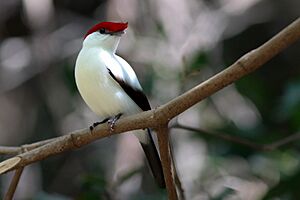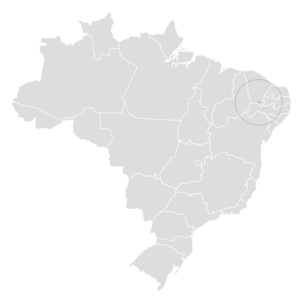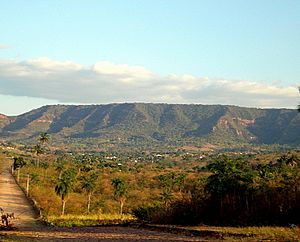Araripe manakin facts for kids
Quick facts for kids Araripe manakin |
|
|---|---|
 |
|
| Male | |
 |
|
| Female on nest | |
| Conservation status | |
| Scientific classification | |
| Genus: |
Chiroxiphia
|
| Species: |
bokermanni
|
 |
|
The Araripe manakin (Chiroxiphia bokermanni) is a special type of bird from the manakin family. It was first found in 1996 and officially described in 1998. This bird's scientific name honors Werner Bokermann, a Brazilian zoologist and filmmaker. He passed away in 1995.
People in Portugal call it soldadinho-do-araripe. This means "little soldier of Araripe." This name comes from its helmet-like red crown. It also links it to the helmeted manakin, a similar bird.
Contents
What Does the Araripe Manakin Look Like?
Like many manakins, male and female Araripe manakins look very different. This is called sexual dimorphism. They are fairly large birds with long tails. They grow to about 14.5 centimeters (5.7 inches) long.
Male Araripe Manakins
Male Araripe manakins are mostly white. Their wings and tail are black. They have a bright red patch that looks like a helmet. This patch goes from their forehead, over their head, and down their back. Their eyes are red.
Female Araripe Manakins
Female Araripe manakins are mostly olive green. Their upper parts are a lighter green. They have a smaller, olive green tuft of feathers on their forehead. This helps them blend in with the forest.
What Do Araripe Manakins Eat?
Araripe manakins eat both plants and small animals. About 80% of their food comes from a plant called Clidemia biserrata. They mainly eat fruit, but they also eat arthropods (like insects).
Female manakins have a wider variety of foods they eat. Their olive-green feathers help them hide better in the forest. This means they can search for food with less risk from predators. Males are bright white, which makes them easier to spot. Females also have a longer beak. This helps them handle and eat more types of fruit than the males can.
Where Do Araripe Manakins Live?
This bird lives only in one specific area. It is found in the Chapada do Araripe uplands. This area is in the state of Ceará in northeastern Brazil. The area is about 50 kilometers (31 miles) long and 1 kilometer (0.6 miles) wide. Their home is special because of the soil from Santana Formation limestone.
The main breeding area for these birds is very small. It is only about 1 square kilometer (0.4 square miles) and is inside a theme park. Scientists think they might live in other places too. However, searches in nearby areas have not found any more of them.
Why Are Araripe Manakins in Danger?
In 2000, there were fewer than 50 Araripe manakins left. They were considered one of the rarest birds in Brazil and the world. Only three males and one female had been found by then. By 2003, estimates were a bit better. BirdLife International thought there were between 49 and 250 birds. In 2004, they believed fewer than 250 existed, based on 43 males found.
A theme park was built in 2000 where these birds live. This park has swimming pools and paved roads. Much of the birds' original home was destroyed. The trees were cut down and replaced with banana farms. The most recent estimate from August 7, 2018, suggests there are about 150 to 700 adult birds left in Brazil.
In 2008, Sir David Attenborough announced he would help protect the Araripe manakin. He wanted to raise money to save this rare bird. At that time, there were about 500 pairs of Araripe manakins left.
Images for kids







